Featured Faculty
Polk Bros. Chair in Retailing; Professor of Marketing
Member of the Department of Marketing faculty between 2006 and 2008
Around Christmas, Celeste Pramberger visited Babies R Us in Tampa, Florida, to exchange an outfit for her then eight-month-old baby, Allie. But the store did not have Allie’s size, so Pramberger asked to return it. She was mortified when the clerk said she could not because she had returned too many past purchases.
“I was so surprised,” Pramberger said. “The only things I had returned had been four months prior from my baby shower registry. It wasn’t like I was reckless, buying things then returning them without a receipt.” Pramberger said that after her baby shower, she had returned about fifteen items within four months priced between $5 and $20 because she’d “gone overboard’ and registered for too many similar blankets, bottles, and “onesie” outfits.
“I wasn’t ungrateful for the gifts, just an indecisive new mom,” said Pramberger, who works in talent and organizational performance for Accenture. Although her returns ban at Babies R Us occurred five years ago, she said the incident left her paranoid even today, resistant to return anything for fear of being embarrassed, even at other stores. And it may have left her gun-shy to purchase items in the first place, for fear of needing to return them later.
People return items for a multitude of reasons, from poor fit to buyers’ remorse. And some stores, like Babies R Us, track their customers’ behavior over time and then tailor their returns policy based upon the customer’s personal shopping history. But are they harming or helping their profit potential by doing so? It is difficult for retailers to parse the tangible and intangible benefits a customer perceives at simply having the opportunity to return a purchase.
Most retailers base their returns policies on a mix of customer data and intuitive business sense, with the goal of protecting profits but also fostering loyal customers who will come back to spend tomorrow. It is a fine line with murky parameters, but companies do not have to rely on trial and error to tweak their returns policies.
Marketing Meets Finance
A new model developed by a team of marketing science researchers allows retailers to plug in two or three years worth of customer data and get hard dollar figures for exactly how much individual customers are willing to pay to have the option to return an item later. The team was led by Eric Anderson (Professor of Marketing at the Kellogg School of Management) and included Karsten Hansen (Associate Professor of Marketing at the Kellogg School of Management) and Duncan Simester (Professor of Management Science at Sloan School of Management).
“I like to say that this study is where marketing meets finance,” Anderson says, “because people in finance price out real options all the time and this is an example of the same kind of problem—but in a marketing context.”
Anderson notes that his team’s study represents the first time anyone has been able to pin a dollar sign on how much a customer values the option to return something. Their model can help retailers to optimize their returns policies for individual customers as well as across product categories and purchasing modes, such as online versus in stores. And because the model monetizes the option to return purchases, Anderson says it can also be applied to parsing gross and net demand changes based on the option to return, and calculating more accurate price elasticities.
Anderson explains that while there is a lot of theoretical literature on customer returns behavior, empirical studies are lacking, which drove him and his team to fill the void.
“Every retailer has a return policy, but there is no empirical evidence as to how effective they are or how much customers value these policies,” Anderson says. “There is just not much evidence about returns in general, although this is an emerging field in marketing science.”
To pinpoint the numbers, his team approached solving the problem from a customer’s perspective and devised a statistical model that chews up customer purchase histories and then spits out the probability of their individual purchase rates and return rates within defined product categories over time (see Figure 1).
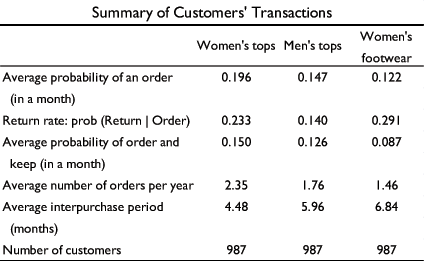
Figure 1: Summary of Customer’s Transactions
The model also calculates how much customers would pay for the option to return purchases within these categories and how a retailer’s returns policy affects whether or not they buy a product. For example, Anderson’s team used household data from 987 individuals over ten and a half years and analyzed their purchases for women’s footwear, men’s tops, and women’s tops from a single retailer that sells through stores, a Web site, and mail catalogs. They purposefully chose these categories for their independence of each other in terms of returns and their variation in return rates. They calculated that while men were only willing to pay $3.19 for the option to return tops, women were willing to pay $5. But the real surprise lay in footwear. Women were willing to pay an extra $15.81 per pair of shoes if they had the option to return them later (see Figure 2) when the average price for shoes was around $50.

Figure 2: The Impact and Value of Returns
“One way to think about that is if you were a direct marketer and people didn’t have the opportunity to return shoes that they hadn’t tried on, you’d have to drop the price down to $35 to sell those shoes,” Anderson says. “For retailers, that is a big deal.”
The model works by calculating the base probability of purchases customers will make (based on their past history), and then recalculates how this probability will change given the option to return the purchase. For example, there is an 8.7 percent chance that an average customer will buy a pair of women’s shoes in a given month if she is allowed to return them (Figure 1). But the probability that she will buy those shoes decreases by 0.030 if she cannot return the item (Figure 2). This translates to a 53 percent increase in demand for women’s shoes if the buyer can return them.
“For footwear, because the purchase rate is so low, the impact of a returns policy upon net demand is huge,” Anderson explains.
Precision Fit
The researchers found less steep increases in demand for women’s tops (16 percent) and even less increase in demand for men’s tops (9 percent), although in all cases the option to return merchandise increased demand. But there was wide variation in how individuals valued the option to return their purchases, and Anderson attributes this spread to the precision of a product’s fit. There is less margin of error for fit in footwear—or in baby’s clothes if we recall Pramberger’s problem—and therefore there is a higher value placed on the ability to return the item when it is bought sight unseen.
“There is a lot of variation in customer’s valuation,” Anderson notes. “A bunch of people place no value at all on these policies.” But some people, he added, purchase more because they have the option to return.
Anderson’s research provides the type of information a retailer could use to customize its return policy to individual customers, such as Pramberger. “Our model would allow a retailer to evaluate how much demand would be lost from a customer if she was not allowed to return a product.”
The model can also be used to distinguish differences in gross and net demand when returns are allowed. Crunching the numbers on women’s tops, the team found that while gross demand increased significantly when returns were allowed, the actual numbers of customers who kept their purchase was only slightly greater, leading to a small increase in net demand. And the shift in demand was consistently greater for lower-priced items versus higher priced items for both net (Figure 3a) and gross demand (Figure 3b).
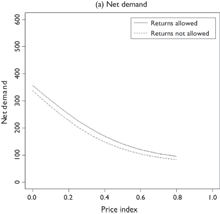 | 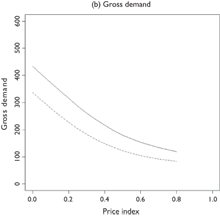 |
Figure 3a and 3b: Demand for Women’s Top
Taking this into account, the researchers’ model can make predictions for maximizing profits based upon a retailer’s current returns policy. A single parameter, K, is used to summarize the ease of a product return policy for each category, with values of K over one indicating an overly strict return policy and values below one an overly lenient policy. The model suggests that for their case study, the returns policy for women’s tops is close to optimal but that returns for men’s tops should be made more stringent, or that the option should be eliminated. For women’s footwear, the returns policy should be made more liberal to capture the maximum profit (see Figure 4).
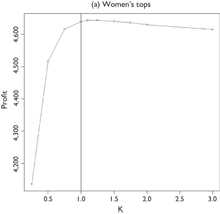
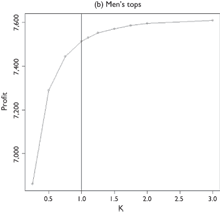
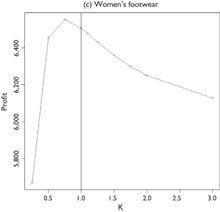
Figure 4: Optimal Return Policies for Each Category
So, is this an academic exercise or will it actually help retailers? “If Babies R Us applied our model,” says Anderson, “they would be able to forecast how Ms. Pramberger’s purchase behavior changed after she was not allowed to return products. Right now, these decisions are made with gut feel. Our model allows retailers to measure the impact of this policy change.”
Anderson believes the model can benefit retailers in three other ways: First, they can measure how changing their returns policy will shift both gross and net demand and calculate expected changes in net profit. Second, they can plug their own customer data into the model to optimize their returns policies across product categories and across selling modes. And third, they can calculate more accurate price elasticities by incorporating changes to their net demand when returns are allowed.
“This model is quite general and can be applied to many types of products, not just retail clothing,” Anderson says. “The model is applicable in any situation where the customer has the option to renege on a purchase.”
Because retailers ultimately want to figure out not just how to market and sell their product, but also how to get their customers to keep it, Anderson believes that future research avenues will investigate how customers learn about the fit of the product, differences in return behavior in different selling modes, and evaluating returns policy in the context of retail competition.
Anderson, Eric T., Karsten Hansen, and Duncan Simester. 2009. The Option Value of Returns: Theory and Empirical Evidence. Marketing Science, 28:3 (May), 405-423.